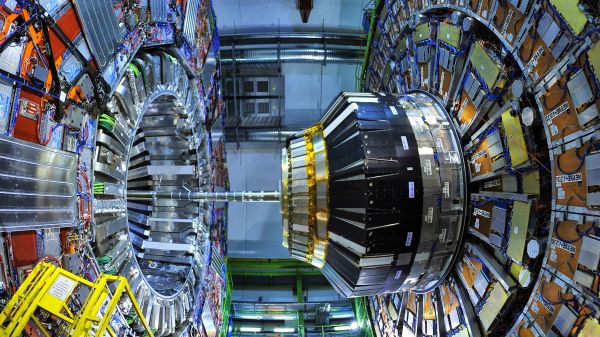This 'charming' particle could have saved the universe
The charm meson could answer why there's more matter than antimatter in the universe.

Scientists working at the world’s largest atom smasher have caught a bizarre subatomic particle in the act of changing from matter to antimatter. The discovery could help us understand how the universe was saved from total annihilation soon after it exploded into existence.
Using data from the second run of the Large Hadron Collider (LHC), researchers from Oxford University spotted the charm meson — a tiny particle that contains both a matter and an antimatter version of the quark, the fundamental building block of matter — transforming back and forth between the two states.
Every particle has an antiparticle counterpart with the same mass, lifetime and atomic spin, but with the opposite charge. Some particles, such as the photon (light particles) are their own antiparticle, whereas others can exist as both matter and antimatter at the same time, thanks to the bizarre quirks of a phenomenon called quantum superposition.
Related: Beyond Higgs: 5 elusive particles that may lurk in the universe
The charm meson falls into this final category. Quantum superposition — which emerges from quantum mechanics, or the strange rules that govern the world of the very small — allows tiny particles to exist in many different states at once, essentially as a mix of different particles, until said particles are observed and pick one state to land in. Instead of just being particles, they are also like little waves, with the magnitude of these waves in any given point in space representing the probability of finding a particle at that point.
When the charm meson (formally called D0) and its antiparticle counterpart (anti-D0) exist in superposition, the waves of D0 and anti-D0 overlap in various ways to form two other matter particles, called D1 and D2, which are also in a state of superposition. Even though D1 and D2 are made up of the same particle (D0) and antiparticle (anti-D0) ingredients as each other, they have slightly different mixtures of each, giving them different masses and lifetimes.
The reverse is also true; D1 and D2 can also superpose to produce D0 or anti-D0, depending upon how they are added on top of each other.
Breaking space news, the latest updates on rocket launches, skywatching events and more!
"You can think of the D0 as made of a mixture of D1 and D2, or D1 as made as a mixture of D0 and anti-D0, it's just two ways of looking at the same phenomena," co-author Chris Parkes, an experimental physicist at the University of Manchester and spokesperson at the LHC, told Live Science.
Because the mass of these particle-waves decides their wavelength, and therefore how they interfere with each other, the difference in mass between the heavier D1 and the lighter D2 that decides how quickly the charm meson switches between its matter (D0) and antimatter (anti-D0) form.
And this difference of mass is absolutely tiny: only 3.5x10 ^ minus 40 ounces (or 0.00000000000000000000000000000000000000001 kilograms).
To make a measurement this precise, the researchers observed 30.6 million charm mesons just after they were made when two protons smashed together inside the LHC. Charm mesons only travel a fraction of an inch before they decay into lighter particles, but the ultra-precise detectors inside the particle accelerator enabled the team to compare the charm mesons that traveled the shortest distance with those that went the farthest. The researchers then used that difference to calculate the difference in mass between the two possible states.
This is the second time that a particle has been caught oscillating between matter and antimatter in this way, the first being a 2006 measurement of the strange-beauty meson. But spotting this in the charm meson was much harder because usually the unstable particle decays before it can make the switch, according to the researchers.
"What makes this discovery of oscillation in the charm meson particle so impressive is that, unlike the beauty mesons, the oscillation is very slow and therefore extremely difficult to measure within the time that it takes the meson to decay," co-author Guy Wilkinson, an experimental physicist at the University of Oxford, said in a statement.
Particles that can make the leap between matter and antimatter are important because they lie at the core of one of the biggest mysteries of science: why the universe exists in the first place.
According to The Standard Model, the theory that describes the fundamental particles that make up the universe, matter and antimatter were created in equal quantities by the Big Bang. Yet the universe we live in is almost entirely made up of matter. And because matter and antimatter annihilate each other on contact, the universe should have annihilated itself the very moment, or soon after, it began. What then, was the cause of the imbalance?
Some hypotheses suggest that particles like the charm meson could have saved the material universe from annihilation — especially if they transition from antimatter to matter more often than they go the other way. With an upgraded LHC due to be switched back on in September after being shut down for more than three years, and similar meson investigations slated to be run by Japan’s Belle II experiment, the discovery of further clues may not be that far away.
The researchers published their findings June 7 on the preprint server arXiv, so the study has yet to be peer-reviewed.
Originally published on Live Science.

Ben Turner is a U.K. based staff writer at Live Science. He covers physics and astronomy, among other topics like weird animals and climate change. He graduated from University College London with a degree in particle physics before training as a journalist. When he's not writing, Ben enjoys reading literature, playing the guitar and embarrassing himself with chess.

